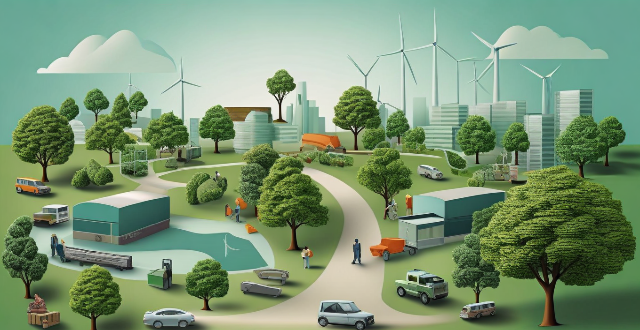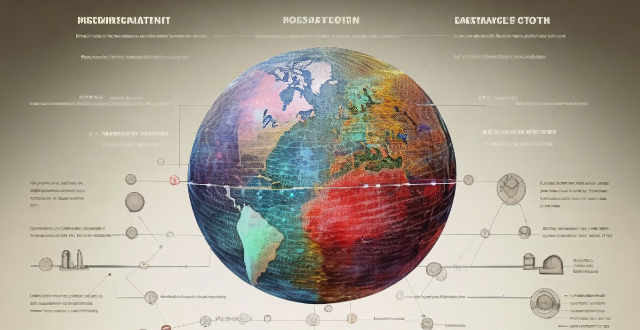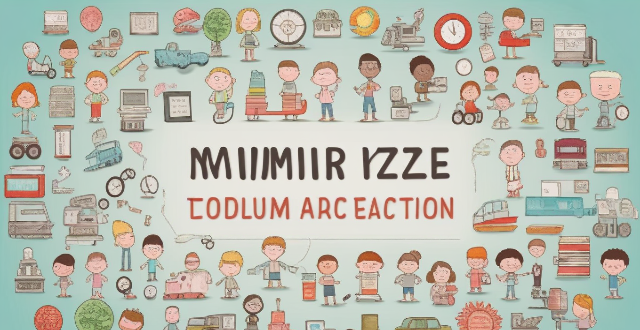Legislation Action

What role do citizens play in shaping environmental legislation ?
The text discusses the significant role that citizens play in shaping environmental legislation. It outlines various ways in which they can influence such legislation, including advocacy and public awareness, voting and elections, lobbying and policy influence, litigation and legal action, and grassroots movements and direct action. The text emphasizes that by working together, citizens can help create a more sustainable future for themselves and future generations.

Can environmental legislation effectively reduce pollution ?
Environmental legislation has the potential to effectively reduce pollution, but its success depends on various factors such as enforcement and compliance, public awareness and participation, technological innovation, political will, international cooperation, and economic considerations. Strong regulatory bodies, education campaigns, investment in clean technology, government prioritization of environmental protection, global collaboration, and balancing environmental goals with economic development are all crucial for the effectiveness of environmental legislation. Achieving lasting improvements in environmental quality requires ongoing effort from all sectors of society.

How does environmental legislation differ across countries ?
Environmental legislation varies across countries due to differences in economic development, political systems, cultural values, and environmental priorities. The legal framework for environmental protection ranges from comprehensive laws covering various issues to piecemeal legislation addressing specific problems. Enforcement mechanisms also differ, with some countries having strong regulatory bodies and others lacking institutional capacity or political will. Penalties and sanctions for non-compliance vary widely, as do opportunities for public participation in decision-making processes. International cooperation is crucial but varies in commitment and action among countries. Overall, these differences highlight the need for greater coordination and cooperation to address global environmental challenges effectively.

How has environmental legislation evolved over time ?
Environmental legislation has evolved over time, reflecting growing awareness of environmental issues. Early stages focused on preserving natural resources and conserving wildlife habitats, while post-World War II saw a shift towards pollution control through air and water quality regulations. The late 20th century introduced comprehensive environmental protection laws addressing multiple aspects of environmental degradation. Today's legislation prioritizes sustainable development and climate change mitigation, with a focus on public participation and transparency in decision-making processes.

What challenges have been faced in the adoption and enforcement of climate change legislation ?
Climate change is a global issue that requires immediate attention and action. The adoption and enforcement of climate change legislation are crucial steps in mitigating the effects of climate change. However, several challenges have been faced in this process, including: 1. Lack of Political Will: Governments often prioritize short-term economic gains over long-term environmental sustainability, making it difficult to pass and implement effective climate policies. 2. Economic Barriers: The high cost associated with transitioning to clean energy sources can be a significant barrier to adopting and enforcing climate change legislation. Additionally, the shift towards clean energy can lead to job losses in traditional industries such as fossil fuel extraction and manufacturing. 3. Legal and Institutional Hurdles: Many countries lack comprehensive legal frameworks for addressing climate change, which can hinder the adoption and enforcement of effective climate policies. Weak enforcement mechanisms can also undermine the effectiveness of climate change legislation. 4. Public Awareness and Participation: Public awareness and understanding of climate change issues are essential for the successful adoption and enforcement of climate change legislation. However, many people still lack a basic understanding of the science behind climate change and its potential consequences. Active public participation is crucial for driving change and holding governments accountable for their actions on climate change. Addressing these challenges requires a concerted effort from governments, civil society organizations, businesses, and individuals worldwide. Only by working together can we hope to mitigate the effects of climate change and secure a sustainable future for all.

What role do governments play in implementing climate action plans ?
Governments play a crucial role in implementing climate action plans by setting targets, enacting legislation, providing incentives, investing in research and development, regulating industries, raising public awareness, developing infrastructure, supporting innovation, and engaging in international diplomacy. These actions help reduce greenhouse gas emissions, promote sustainable development, and build resilience against the impacts of climate change.

How does climate change legislation influence corporate sustainability practices ?
Climate change legislation significantly influences corporate sustainability practices by setting standards for environmental responsibility. It compels companies to report on their environmental impact, use market-based mechanisms like cap-and-trade systems, and consider tax incentives or penalties in their operations. This legislation also creates investor pressure through ESG criteria and shareholder resolutions, leading companies to enhance their sustainability practices to meet investor expectations. Additionally, it opens market opportunities for green products and services and encourages renewable energy adoption. Companies that comply with climate legislation can improve their brand image and stakeholder engagement. Furthermore, such legislation aids in risk management by requiring companies to assess physical and transition risks associated with climate change. Overall, climate change legislation is a driving force behind corporations adopting more sustainable practices.

What are the economic implications of enacting stringent climate change legislation ?
The article discusses the economic implications of stringent climate change legislation, which include job creation in renewable energy and green infrastructure sectors, potential increases in energy and food prices, new business opportunities in innovation and carbon trading, and investment in clean technology leading to economic growth. However, there are also short-term transition costs and job displacement issues. Despite these challenges, the long-term benefits such as improved air quality and increased resilience against natural disasters make the implementation of such legislation beneficial for future generations.

How effective has the recent climate change legislation been in reducing greenhouse gas emissions ?
The effectiveness of recent climate change legislation in reducing greenhouse gas emissions has been variable, with some regions and policies showing significant success while others face numerous barriers.

How can individuals contribute to climate action advocacy ?
Individuals can contribute to climate action advocacy by engaging in educational and awareness-raising activities, making lifestyle changes to reduce their carbon footprint, participating in community initiatives, providing financial support to environmental organizations, and engaging in advocacy and activism. These actions help promote policies and practices that mitigate climate change and adapt to its impacts, ultimately fostering a culture of sustainability.

What are some successful examples of youth-led climate action initiatives ?
This article discusses successful youth-led climate action initiatives around the globe, highlighting examples like Fridays for Future, US Youth Climate Strike, and Earth Uprising. These movements have achieved significant milestones in raising awareness, inspiring policy changes, and fostering collective action towards addressing climate change.

How can social media be used to mobilize young people for climate action ?
The text discusses how social media can be utilized to engage and mobilize young people for climate action. It outlines strategies for raising awareness, fostering dialogue, and driving concrete actions through educational content, influencer partnerships, hashtag campaigns, discussion forums, interactive polls and surveys, user-generated content, volunteer opportunities, online activism, and practical tips for sustainable living. The conclusion emphasizes the potential of social media as a tool for social change and calls for its wise use to shape a brighter future.

How can we ensure that climate action benefits both men and women equally ?
Ensuring gender equality in climate action is crucial for addressing the differential impacts of climate change on men and women. To achieve this, we must recognize gender-specific impacts, encourage gender equality in policy making, integrate gender perspectives in adaptation and mitigation measures, enhance access to resources and services, support capacity building and empowerment, address cultural and social norms, and monitor progress to adjust strategies accordingly. By doing so, we can promote a more equitable future where climate action benefits both genders equally.

What are the key provisions of the latest climate change legislation ?
The latest climate change legislation is a comprehensive package of measures aimed at addressing the challenges posed by global warming and climate change. The key provisions include reduction of greenhouse gas emissions, adaptation to climate change impacts, international cooperation and leadership, just transition for workers and communities, and transparency and accountability.

How does climate legislation vary across different countries ?
Climate legislation varies across countries due to factors such as government involvement, emphasis on different sectors, stringency of emission targets, and international cooperation. Some countries focus on reducing emissions from transportation or energy production, while others prioritize agriculture or waste management. The level of government involvement also differs, with some countries relying more on local or regional authorities. Additionally, the stringency of emission targets set by different countries varies widely. International cooperation and compliance with global climate agreements also play a role in shaping climate legislation across countries.

How can we encourage individuals and communities to take action on climate change adaptation ?
Encouraging individuals and communities to take action on climate change adaptation requires a multi-faceted approach that includes education, policy changes, economic incentives, community engagement, and technological innovation. This involves raising public awareness through workshops, media campaigns, and integrating climate change topics into educational curricula. Developing and implementing adaptation policies at local and national levels is crucial, along with promoting green infrastructure and sustainable practices. Offering financial incentives such as tax breaks and grants can encourage the adoption of energy-efficient technologies and eco-friendly products. Support for community-based projects is also essential, including funding for initiatives and capacity building. Fostering community leadership and encouraging civic participation through volunteer programs and town hall meetings can further inspire collective action. Promoting research and development, adopting advanced technologies, and using renewable energy sources are also vital components in this comprehensive approach. By working together, we can build a more resilient future for all.

What role do scientists play in shaping climate change legislation ?
Scientists play a crucial role in shaping climate change legislation by providing evidence-based research, influencing policy development, and educating the public and raising awareness about the issue. Their expertise helps policymakers understand the severity and potential consequences of climate change, identify patterns and predict future scenarios, assess impacts on ecosystems and human health, advise on effective strategies for addressing climate change, testify before government bodies, participate in public forums and debates, publish scientific papers and reports, collaborate with media outlets, and participate in educational programs and workshops.

What is the impact of environmental legislation on businesses ?
This article discusses the impact of environmental legislation on businesses, including cost implications, reputation and brand image, innovation and competitive advantage, and legal risks and liability. It highlights the need for businesses to comply with these laws and regulations to avoid negative consequences and position themselves as leaders in sustainability and innovation.

How can young people get involved in climate action ?
Young people can get involved in climate action by educating themselves, joining youth organizations, advocating for change, taking local action, volunteering, and supporting sustainable businesses.

How effective are youth-led climate action campaigns ?
Youth-led climate action campaigns are effective in mobilizing young people, employing creative strategies, attracting media attention, influencing policymakers, and focusing on education and awareness.

How is climate change legislation being implemented at the local government level ?
Local governments are implementing climate change legislation through various strategies, including adopting green building codes, promoting renewable energy development, implementing transit-oriented development policies, investing in infrastructure resilience, and promoting sustainable land use practices. These efforts aim to reduce greenhouse gas emissions, prepare for the impacts of climate change, and create more resilient and sustainable communities.

What are the benefits of taking climate action ?
Taking climate action is crucial for the survival and well-being of our planet and its inhabitants. Here are some of the benefits that come with taking climate action: 1. Health Benefits: - Improved Air Quality: Reducing greenhouse gas emissions can help improve air quality, leading to fewer respiratory problems and a lower risk of lung cancer. - Reduced Heat-Related Illnesses: Taking steps to mitigate climate change can help reduce the frequency and intensity of heatwaves, which in turn reduces the risk of heat-related illnesses like dehydration and heat exhaustion. 2. Economic Benefits: - Job Creation: Investing in renewable energy sources like wind and solar power creates jobs in manufacturing, installation, and maintenance. - Cost Savings: By reducing our dependence on fossil fuels, we can save money on energy bills and reduce the economic impact of fluctuating oil prices. 3. Environmental Benefits: - Biodiversity Preservation: Taking climate action helps protect habitats and ecosystems, preserving biodiversity and preventing species extinction. - Water Conservation: Mitigating climate change can help preserve water resources by reducing the severity and frequency of droughts. 4. Social Benefits: - Community Resilience: Taking climate action can help build more resilient communities by preparing for and adapting to the impacts of climate change. - Public Awareness: Climate action raises public awareness about environmental issues, promoting a culture of sustainability and encouraging individuals to make eco-friendly choices in their daily lives. In conclusion, taking climate action offers numerous benefits that extend beyond just protecting the environment. It's essential for our health, economy, and social well-being. By working together to reduce greenhouse gas emissions and adapt to the changing climate, we can create a more sustainable and resilient future for all.

How can we ensure that climate action is consistent with human rights ?
To ensure that climate action is consistent with human rights, we need to adopt a holistic approach that takes into account the social, economic, and environmental dimensions of sustainability. Some strategies include recognizing the interdependence between climate action and human rights, integrating human rights into climate policy, ensuring transparency and accountability, promoting participatory democracy, strengthening legal frameworks, and building capacity and providing support to vulnerable populations. By doing so, we can create a more equitable and just world for all.

What challenges do young people face when trying to participate in climate action ?
The text summarizes the challenges faced by young people in climate action. These include a lack of awareness and education, limited resources and opportunities, social and political barriers, emotional and psychological challenges, and practical difficulties. Despite these obstacles, it is crucial for young individuals to engage in climate action to create positive changes and contribute to a more sustainable future.

How do people's attitudes towards climate change affect their willingness to take action on environmental issues ?
The text discusses how attitudes towards climate change influence environmental action. It identifies factors like awareness, emotional connection, responsibility, barriers, and incentives that shape willingness to act on environmental issues.

What are the challenges in implementing environmental legislation ?
The text discusses the challenges in implementing environmental legislation, including lack of awareness and education, insufficient funding and resources, political will and support, legal and administrative hurdles, technological limitations, and international cooperation and coordination. Addressing these challenges requires a multi-faceted approach involving education, advocacy, policy reform, and collaboration at all levels of society.

How can businesses be encouraged to take climate action ?
Climate change is a global challenge that requires collective action from businesses. Government regulations and incentives, public pressure, long-term financial benefits, collaboration with other businesses, and education and awareness campaigns are some ways to encourage businesses to take climate action. By taking action, businesses can reduce their environmental impact, save money on utility bills and disposal costs, and benefit from stable sources of renewable energy.

How can we ensure compliance with environmental legislation ?
Ensuring compliance with environmental legislation is crucial for protecting the planet and its inhabitants, and can be achieved through education and training of stakeholders, developing and implementing policies, monitoring and reporting performance, and collaborating with stakeholders.

What are the most effective ways to advocate for climate action ?
Advocating for climate action is crucial in the face of escalating global warming and its associated environmental, social, and economic impacts. Here are some of the most effective ways to make your voice heard and inspire change: 1. **Raise Awareness Through Education**: Organize community workshops, share knowledge on social media, and engage with schools to include climate education in their curriculum. 2. **Support Legislation and Policies**: Vote for green candidates, contact elected officials, and participate in policy making by attending public hearings. 3. **Promote Sustainable Living**: Advocate for renewable energy use, reduce waste, reuse products, recycle materials, and promote sustainable transportation. 4. **Participate in Local and Global Initiatives**: Join environmental organizations, organize or join protests, and gather signatures for petitions that demand climate action from governments and businesses. 5. **Innovate and Inspire**: Support initiatives that develop new technologies for sustainable living and clean energy, implement eco-friendly practices within your business operations, and use art, music, film, and literature to communicate the urgency of climate action in compelling ways. 6. **Build Partnerships and Collaborations**: Engage religious communities in discussions about climate change and encourage green practices within faith institutions, work with companies to promote corporate social responsibility through sustainable practices, and support and engage in international agreements and cooperation on climate action, such as the Paris Agreement. 7. **Practice What You Preach**: Make conscious choices in your daily life that align with your advocacy, such as consuming less meat, using energy-efficient appliances, and minimizing water usage. By employing these strategies, you can effectively advocate for climate action and contribute to global efforts to mitigate the adverse effects of climate change. It's important to remember that every small action counts and that collective effort can lead to significant change.

How can we ensure that climate debt is taken seriously by governments and corporations ?
Climate debt, a concept recognizing the cumulative GHG emissions primarily from industrialized nations and their impacts on vulnerable populations, calls for action. Strategies to ensure its serious consideration by governments and corporations include raising public awareness, implementing policy initiatives, utilizing financial mechanisms, enhancing international cooperation, promoting corporate responsibility, fostering innovation, ensuring accountability, and engaging in socially responsible actions. These efforts aim to create an environment where stakeholders actively work towards mitigating climate change's impacts.